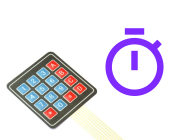
KeyPad Timer
Introduction
If you want to make an electronic lock, using a KeyPad is the obvious way. There's one of these in the Espruino Ultimate kit, but see the KeyPad page to see where you can buy them.
You'll Need
- One Espruino Board
- A KeyPad
Wiring Up
Just plug the Key Pad in to B2,B3,B4,B5,B6,B7,B8 and B9 (they're one long row of pins) so that as the KeyPad is facing you, the wire nearest D goes to B2, and the wire nearest * goes to B9. There are no real requirements for the pins you can use, but if you use different pins then you'll have to change the software below.
Software
The first step is to respond when a button is pressed. Connect to the Espruino, copy and paste this into the right-hand window, and click the Send to Espruino button:
function onKey(key) {
console.log("123A456B789C*0#D"[key]);
}
require("KeyPad").connect([B2,B3,B4,B5],[B6,B7,B8,B9], onKey);
Note that we can't paste this into the left-hand side initially, because it uses the KeyPad module which the Web IDE needs to be able to load off the internet for you.
Now, when you press a key that character will be output on the screen.
The next step is to add each character together to make a long number (as long as it is in the range 0-9). If it's not a number we'll just assume we want to start the timer.
Copy and paste the following into the right-hand side and click Send to Espruino:
function startTimer(time) {
console.log("Start "+time+" sec counter");
}
var value = "";
function onKey(key) {
var ch = "123A456B789C*0#D"[key];
if ("0123456789".indexOf(ch)<0) {
// it's not numeric then just start the timer...
startTimer(parseInt(value, 10/*decimal*/));
value = "";
} else {
// otherwise save this value...
value += ch;
console.log(value); // write it out...
}
}
require("KeyPad").connect([B2,B3,B4,B5],[B6,B7,B8,B9], onKey);
If you press digits on the Key Pad now, they'll be output on the screen - and if you press something else, like A, it'll output the full number and reset:
// press 1
1
// press 2
12
// press 3
123
// press 4
1234
// press A
Start 1234 sec counter
Next, we can make the timer itself... Just copy and paste the following code over the top of the old startTimer function:
var timerInterval;
var timerCount;
function timerFinished() {
// light the red LED for a second to signal that we're done
digitalPulse(LED1, 1, 1000);
}
function startTimer(time) {
// clear the current timer (if there was one)
if (timerInterval!==undefined)
clearInterval(timerInterval);
timerInterval = undefined;
// if there was a time (it wasn't just blank), start the timer
if (time>0) {
console.log("Start "+time+" sec counter");
timerCount = time;
// Call this every second...
timerInterval = setInterval(function() {
// decrement our counter
timerCount--;
if (timerCount<=0) {
// if we reached zero, stop our timer and call timerFinished()
clearInterval(timerInterval);
timerInterval = undefined;
timerFinished();
} else {
// otherwise just blink the green LED
digitalPulse(LED2, 1, 100);
}
}, 1000);
}
}
And now, if you type a number (unless you're really patient, type a small number!) and press a non-numeric key then the timer will start. The green LED will flash until the time is elapsed, and then the red LED will stay on for 1 second.
This page is auto-generated from GitHub. If you see any mistakes or have suggestions, please let us know.